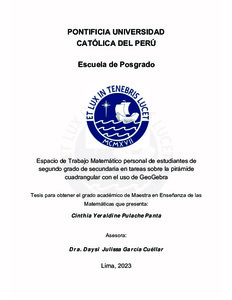| dc.contributor.advisor | García Cuéllar, Daysi Julissa | |
| dc.contributor.author | Pulache Panta, Cinthia Yeraldine | |
| dc.date.accessioned | 2023-11-08T20:25:21Z | |
| dc.date.available | 2023-11-08T20:25:21Z | |
| dc.date.created | 2023 | |
| dc.date.issued | 2023-11-08 | |
| dc.identifier.uri | http://hdl.handle.net/20.500.12404/26377 | |
| dc.description.abstract | Esta investigación tiene por objetivo analizar el trabajo matemático de estudiantes de segundo
grado de secundaria cuando se enfrentan a tareas sobre la pirámide cuadrangular utilizando
GeoGebra, dado que investigaciones antecedentes reportaron dificultades relacionadas con el
aprendizaje de este objeto matemático. Además documentos como el Currículo Nacional y la
National Council of Teachers of Mathematics, destacan la importancia del estudio de este objeto.
La metodología de investigación que se utiliza es de tipo cualitativa, y está basada en el conjunto
de fases propuestas por Hernández, Fernández, y Baptista, la cual se adapta a la naturaleza y
al objetivo de esta investigación. Para el análisis de los resultados se tomaron en cuenta
elementos teóricos y metodológicos de la teoría del Espacio de Trabajo Matemático, la cual
constituye una herramienta valiosa para analizar el trabajo matemático tomando en cuenta
procesos cognitivos y elementos epistemológicos.
Los estudiantes que participaron de este estudio pertenecen a una institución educativa pública
rural de Piura. Las tareas que se aplicaron para el recojo de la información fueron adaptadas de
una ficha de actividades implementada en la estrategia Aprendo en Casa en el año 2020, que
involucra el estudio de este objeto matemático. Los resultados muestran que las génesis que se
activaron en mayor medida son las semiótica e instrumental. Este trabajo de investigación
constituye un punto de partida para el estudio del trabajo matemático de los estudiantes cuando
resuelven tareas que involucran el estudio de algún sólido geométrico. | es_ES |
| dc.description.abstract | The objective of this research is to analyze the mathematical work of second grade secondary
school students when they face tasks about the quadrangular pyramid using GeoGebra, since
previous research reported difficulties related to the learning of this mathematical object. In
addition, documents such as the National Curriculum and the National Council of Teachers of
Mathematics highlight the importance of studying this object.
The research methodology used is qualitative and is based on the set of phases proposed by
Hernández, Fernández, and Baptista, which is adapted to the nature of the objective of this
research. For the analysis of the results, theoretical and methodological elements of the
Mathematical Workspace theory were considered, which constitutes a valuable tool for analysing
mathematical work, taking into account cognitive processes and epistemological elements.
The students who participated in this study belong to a rural public educational institution in Piura.
The tasks that were applied to collect the information were adapted from an activity sheet
implemented in the Aprendo en Casa strategy in 2020, which involves the study of this
mathematical object. The results show that the geneses that were activated to a greater extent
are semiotic and instrumental. This research work constitutes a starting point for the study of
students' mathematical work when solving tasks that involve the study of a geometric solid. | es_ES |
| dc.language.iso | spa | es_ES |
| dc.publisher | Pontificia Universidad Católica del Perú | es_ES |
| dc.rights | info:eu-repo/semantics/openAccess | es_ES |
| dc.rights.uri | http://creativecommons.org/licenses/by/2.5/pe/ | * |
| dc.subject | Educación secundaria--Estudio y enseñanza--Perú--Piura | es_ES |
| dc.subject | Matemáticas--Estudio y enseñanza--Perú--Piura | es_ES |
| dc.subject | Geometría--Estudio y enseñanza--Innovaciones tecnológicas | es_ES |
| dc.subject | Sistemas informáticos--Estudio y enseñanza | es_ES |
| dc.title | Espacio de Trabajo Matemático personal de estudiantes de segundo grado de secundaria en tareas sobre la pirámide cuadrangular con el uso de GeoGebra | es_ES |
| dc.type | info:eu-repo/semantics/masterThesis | es_ES |
| thesis.degree.name | Maestro en Enseñanza de las Matemáticas | es_ES |
| thesis.degree.level | Maestría | es_ES |
| thesis.degree.grantor | Pontificia Universidad Católica del Perú. Escuela de Posgrado | es_ES |
| thesis.degree.discipline | Enseñanza de las Matemáticas | es_ES |
| renati.advisor.dni | 41784433 | |
| renati.advisor.orcid | https://orcid.org/0000-0003-0243-6353 | es_ES |
| renati.author.dni | 47458338 | |
| renati.discipline | 199117 | es_ES |
| renati.juror | Flores Salazar, Jesus Victoria | es_ES |
| renati.juror | Garcia Cuellar, Daysi Julissa | es_ES |
| renati.juror | Campos Motta, Magaly Ethel | es_ES |
| renati.level | https://purl.org/pe-repo/renati/level#maestro | es_ES |
| renati.type | https://purl.org/pe-repo/renati/type#tesis | es_ES |
| dc.publisher.country | PE | es_ES |
| dc.subject.ocde | https://purl.org/pe-repo/ocde/ford#5.03.01 | es_ES |







